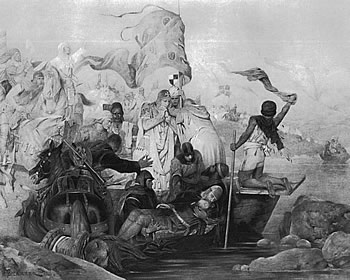Kingdom of Cilicia (part 1)
Establishment of Rubenids dynasty
After the devastating raids of Seljuks thousands of Armenians moved toward Cilicia – region of Armenia Minor situated between the Taurus and Amanus mountains close to Mediterranean coast. The Armenian population in Cilicia gradually became predominant. In 1080 Prince Ruben, that the historians believe to be descendant of the Bagradouni and Ardzrouni dynasties (possibly grandson of Gagik I), asserted authority over the local Armenian and Greek princes. Ruben became founder of a new glorious royal House of Rubenids that ruled over Cilicia for more than 300 years.
Ruben I and his successors maintained close contacts with the Crusaders. As a result, the new Armenian Principality, which later became Kingdom, imitated the principles of State organization accepted in European countries. A number of new ranks and titles were established. Armenian Nakharars became Knights and Barons, Sparapets were often called Constables etc. The Armenian Cilician noblemen used the Latin and French languages alongside the Armenian. Intermarriages between the members of the Armenian and European noble families were widespread.
The first rulers of Cilicia
 Emperor John II Comnenus, depicted in Cathedral of Constantinople (Hagia Sophia)
Emperor John II Comnenus, depicted in Cathedral of Constantinople (Hagia Sophia)
The first Armenian rulers of Cilicia, such as Constantine I and Thoros I led successful warfare against both Saracens and Greeks. The next ruler, the bellicose Levon(occasionally numbered as Levon I thought he was not a king) was less fortunate, as the Emperor John II Comnenus arrested him and seized all of his domains. Later Leon and his elder son Ruben were murdered in prison, but Leon’s younger son Thoros known as Thoros II was spared.
5 years later, Thoros II escaped to Cilicia to declare the country’s independence. Then the Emperor Manuel I Comnenus sent his commander Andronicus (later known as Emperor Andronicus I Comnenus) to punish the fugitive prince. However, Thoros defeated the Greek army several times. Unable to subject Thoros, the Greeks even concluded a military alliance with Sultan of Konya, but the troops of the latter were also routed by Thoros.
Leon I and the Crusaders
 King Levon I with his wife Keran, and five children, on a 1272 manuscript
King Levon I with his wife Keran, and five children, on a 1272 manuscript
During the ruling of Prince Levon, when Cilicia enjoyed the period of a prosperous development, the Third Crusade was proclaimed in Europe. The Roman Emperor Frederic I Barbarossa, the French King Philip II Augustus and the English King Richard the Lion-Hearted assembled their forces to recapture Jerusalem from Saladin.
Arriving in Asia Minor, Frederic Barbarossa proposed an alliance to Prince Levon. The Armenian ruler promised to supply the Europeans with food and horses. Although Frederic I was tragically drowned in the Calycadnus River in Cilicia, Levon continued to support the Crusaders. Wishing to reward Leon for his loyalty, Henry IV, the son of Frederic Barbarossa, sent him a splendid crown. Levon was proclaimed King of Armenia. He is known as Levon I (sometimes numbered Levon II, aslo known as Levon the Magnificent.)
Several leaders of the Third Crusade promised their friendship and protection to the new Cilician Kingdom. Nevertheless, the European monarchs and the Popes of Rome were never disinterested toward the Armenian state. Some religious concessions and the further reunion of the Armenian and Catholic churches were stipulated as an important condition.
The Cilician Armenian Kingdom was reinforced after Levon I gained the long-term conflict over the Latin princes of the neighboring Antioch Principality. The Armenian King captured Antioch twice. He also marked the end of his ruling with victories over the Sultans of Konya and Aleppo.
The Armenian Renaissance
 Nerses Shnorhali (the Graceful), elected Catholicos of All Armenians in 1165, was an outstanding literary figure in Armenian Ecclesiastical Literature. Painting from Echmiadzin CathedralWhile the inhabitants of the Greater Armenia eye-witnessed the loss of their national statehood and numerous foreign invasions, the Cilician Armenians lived in wealth and prosperity. Good geographic location involved the country into an intensive international trade. Science and culture flourished. This period of Armenian history is regarded as the brilliant Age of Ecclesiastical manuscript painting. The school of genius Thoros Roslin was especially famous. Theology, philosophy, rhetoric, medicine and mathematics were taught in a large number of new schools and monasteries. New significant names appeared in the Armenian literature, such as: Nerses Shnorhali, Matthew of Edessa, Vardan Aygektsi and Sembat the Constable.
Nerses Shnorhali (the Graceful), elected Catholicos of All Armenians in 1165, was an outstanding literary figure in Armenian Ecclesiastical Literature. Painting from Echmiadzin CathedralWhile the inhabitants of the Greater Armenia eye-witnessed the loss of their national statehood and numerous foreign invasions, the Cilician Armenians lived in wealth and prosperity. Good geographic location involved the country into an intensive international trade. Science and culture flourished. This period of Armenian history is regarded as the brilliant Age of Ecclesiastical manuscript painting. The school of genius Thoros Roslin was especially famous. Theology, philosophy, rhetoric, medicine and mathematics were taught in a large number of new schools and monasteries. New significant names appeared in the Armenian literature, such as: Nerses Shnorhali, Matthew of Edessa, Vardan Aygektsi and Sembat the Constable.










